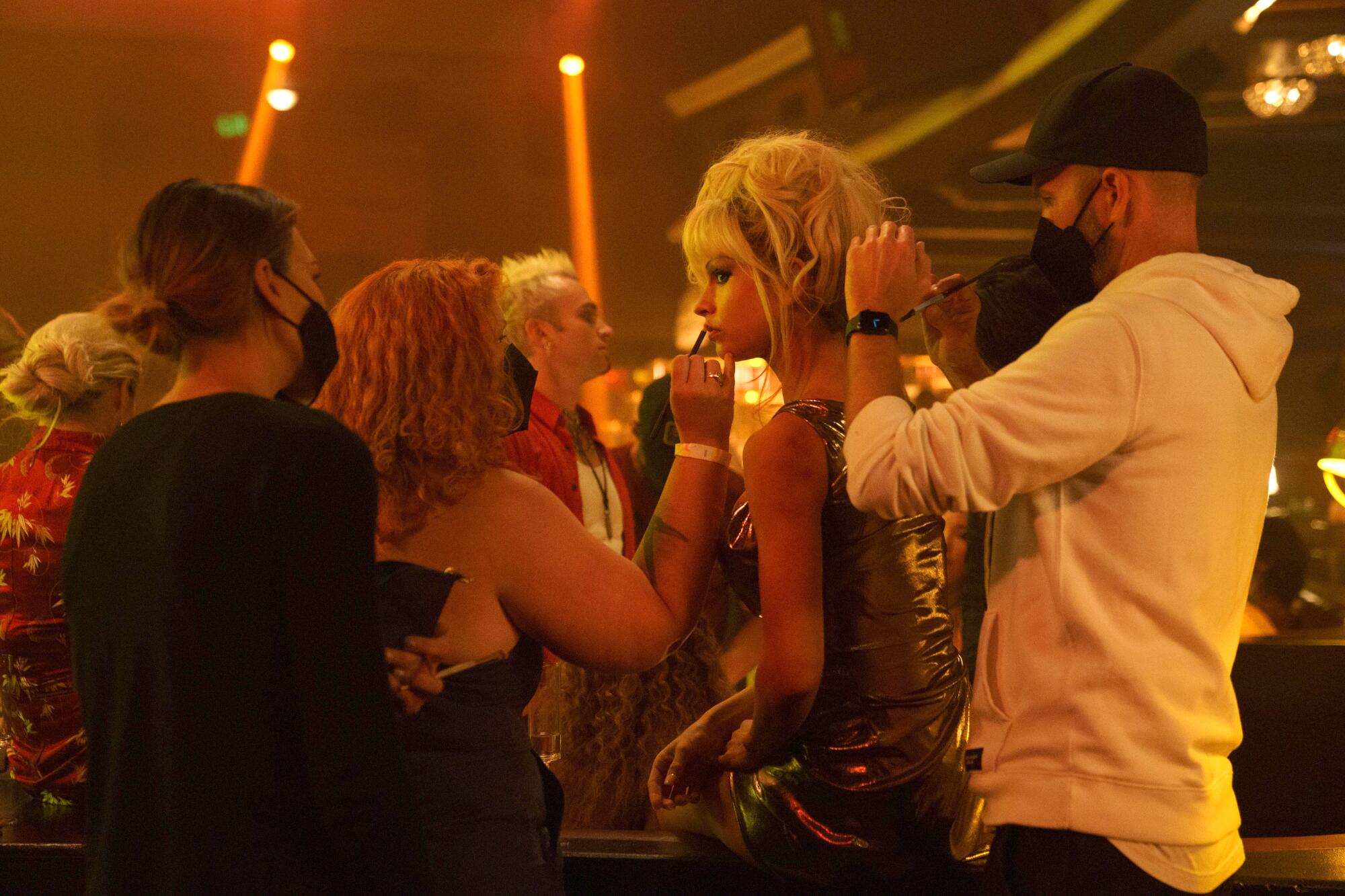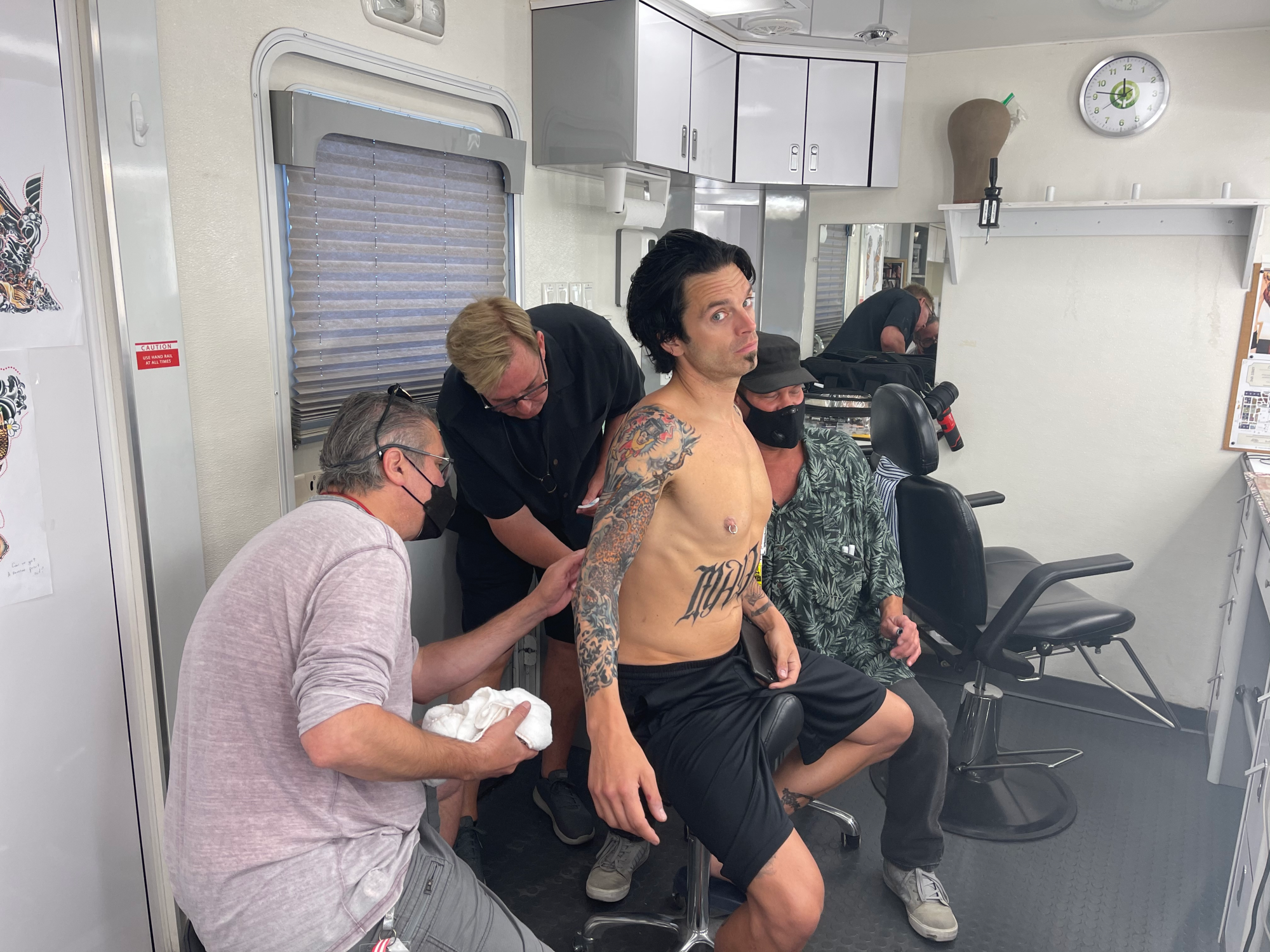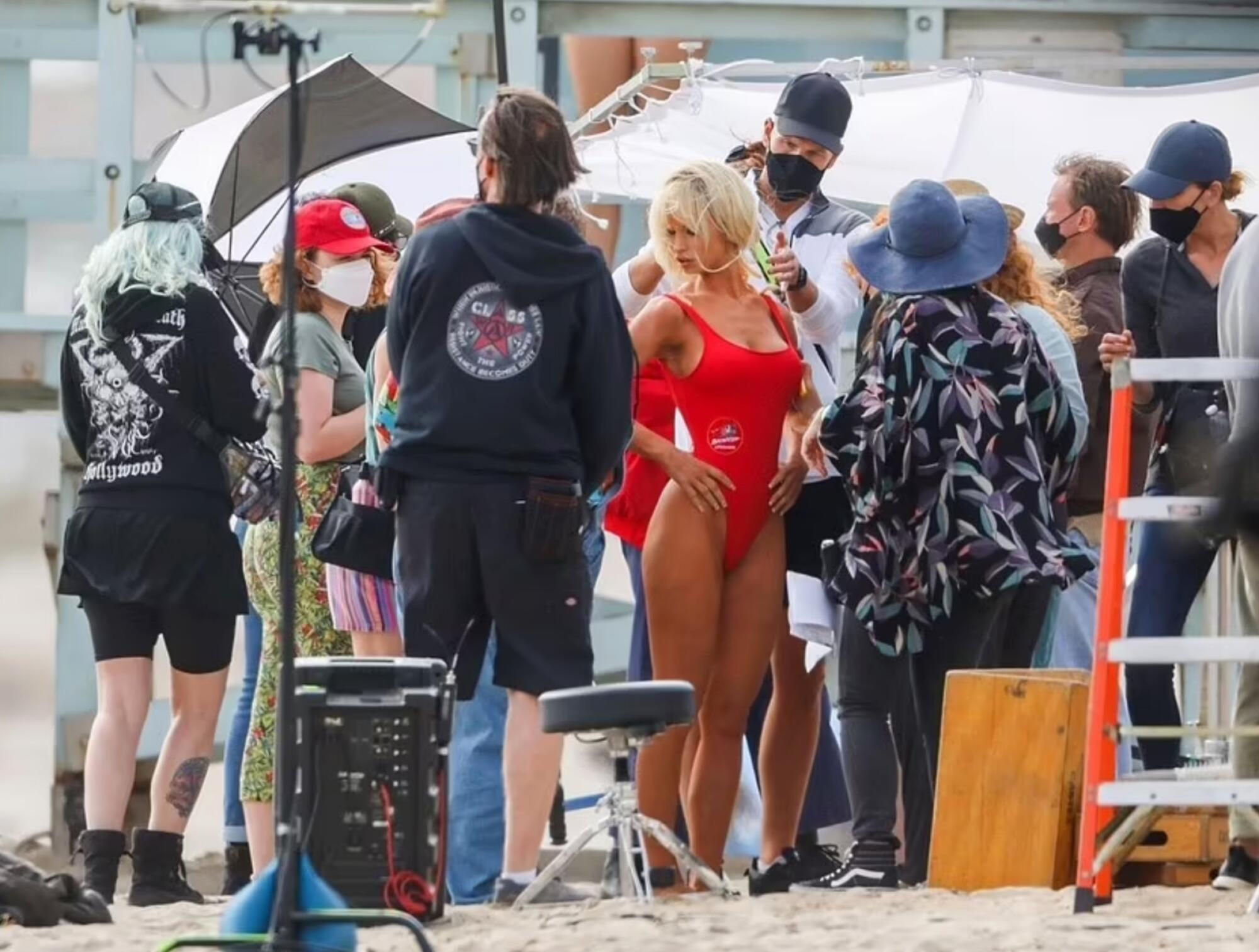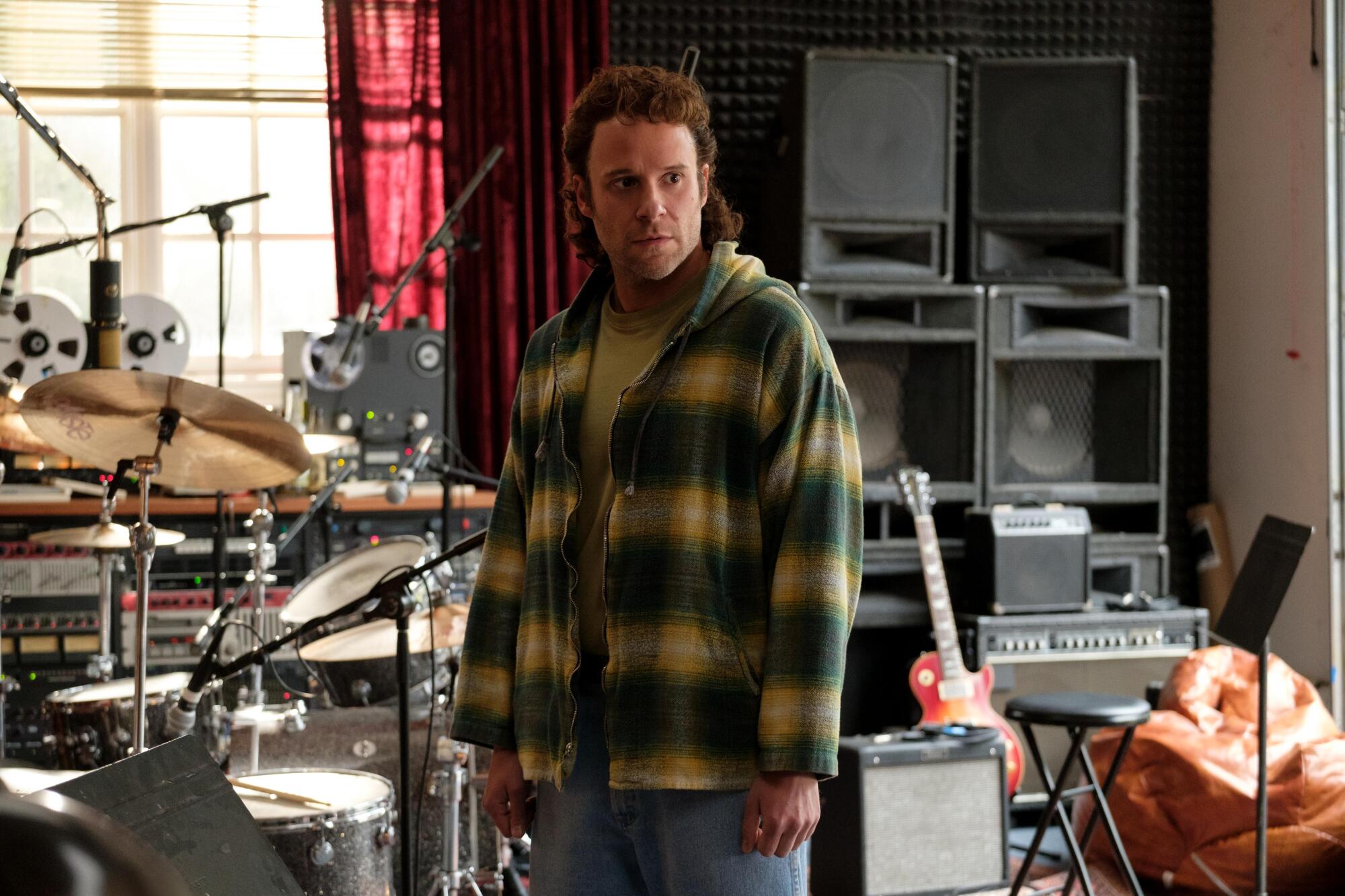
- Share via
The outrageous story of the internet’s first celebrity sex tape so frequently borders on the absurd that any retelling could quickly become a farce. To avoid that fate, the Hulu limited series “Pam & Tommy” faithfully and meticulously re-creates the 1990s tale about the whirlwind romance of “Baywatch” star Pamela Anderson and Motley Crue drummer Tommy Lee, and the torturous consequences of a stolen videotape of their honeymoon lovemaking.
Where many productions might use computer-generated wizardry, the hair and makeup team here relied on handcrafted artistry and every tool in their arsenal. The crew’s many challenges included transforming Lily James, a pale, slight British actress, into Anderson, the perennially tanned, busty Malibu sex symbol — and making a rock star’s penis talk.
As head of the makeup department, David Williams controlled every character’s look — including actors playing Tommy Lee and his Motley Crue bandmates, Jay Leno, Hugh Hefner, Penthouse publisher Bob Guccione and private investigator Anthony Pellicano. He coordinated Barry Lee Moe’s wig and hairstyling team and the special effects from Jason Collins of Van Nuys’ Autonomous F/X, which crafted dozens of face and body prosthetics.

“The Lily makeup is the most comprehensive character makeup that I think any of us have done,” said Williams, a three-time Emmy winner who is also nominated for the Peacock limited series “Angelyne.”
”The vast majority of creating this look was painting highlights and shadows and contours and restructuring a great structure that was already there. We were turning one beautiful woman into another beautiful woman,” Williams said.
With the Hulu series’ short, potent sixth episode, writer Sarah Gubbins and director Hannah Fidell capture a woman in crisis. Here’s how they did it.
Nearly 70 prosthetic foreheads were used on James to match Anderson’s higher hairline and facial structure, while about 25 eyebrow appliques remade her signature pencil-thin arches.
Moe designed and styled 27 custom wigs handcrafted by Wigmaker Associates in Beverly Hills, including Anderson’s trendsetting messy up-dos. James managed to disguise her British accent wearing dentures to invoke Anderson’s capped-teeth smile.
To create Anderson’s buxom figure, Collins’ team made a chest cast of James then built molds to produce gel-filled silicone prosthetics that glued onto the body, extending past her clavicle. Each of the 45 to 50 one-time-use appliances were then airbrushed on the body to blend into the spray-tan skin tone.
“Every stitch of her was painted–skin tone, everything, down to her fingernails,” Williams said. James required four hours of makeup each day, while co-star Sebastian Stan’s transformation into Lee required about three hours, including application of nipples cast from his own in silicone that could be pierced with rings.

Collins said 70 sets of digitally printed tattoos were applied in sections to correspond with Lee’s 35 tattoos that cover his torso, back and arms. All had to be altered slightly and reviewed by lawyers to avoid copyright infringement, Collins said. James also wore tattoos, some which matched her birthmarks. The stars drenched it all in ocean waves, bathtubs and sweat.
Anderson and Lee’s iconic hairstyles challenged Moe to get the pieces right. Stan had his hair dyed, chemically straightened and slicked with pomade to achieve the drummer’s sweaty, dirty locks. Anderson, etched into memory with 14 Playboy covers and 110 “Baywatch” episodes, was the ‘90s gold standard for box-blond, dark-root up-dos.
“As much as I could, I didn’t want it to look like a caricature of Pam,” Moe said. “Our whole trailer was surrounded and covered in pictures of Pam so that Lily and I had a catalog of images to pull from to approach each scene.” Moe often worked one section at a time on a rotating set of wigs, checking against photos to copy the hang and bend of individual tendrils.
“Those tiny details seemed crazy, but that side-by-side comparison helped make it look natural and beautiful on Lily in the end,” he said.

For Seth Rogen’s character, a woeful carpenter, Moe made a longish mullet modeled on his own father, who worked for a Wisconsin telephone company in the ‘80s and ‘90s.
“He always had that beautiful, curly mullet that covered his neck to keep it from getting sunburned,” Moe said.
Touches of realism appeared in the most unexpected places, such as the scene taken from Lee’s autobiography where a naked Lee talks to his penis about Anderson, and it talks back.
“It’s a mechanical penis that is cable controlled,” effects designer Collins said, adding that a special sock apparatus was molded and glued on. Two puppeteers worked cables that ran down Stan’s legs.
“We have more dexterity with four-way pull — left right, up down. We were able to get more throw for the penis to look up at him, to look side to side, shake its head side to side and all of that stuff, with a cable control,” Collins said. “The mouth was a small little mechanism, a push-pull.
“What’s really great when you have a puppet, versus something that is CG and not ‘there’ is that it gives the actor somebody to play against,” Collins said.

Williams was careful to make that moment of high comedy fit the tone. “I have done a lot of sketch comedy in my career. When you’re doing absurdity … everything else around it needs to look and feel real,” Williams said.
The many somber moments were perhaps more challenging aesthetically. Though Anderson was very literally overexposed during her early career, Williams wanted to bring viewers closer to the real woman. In several heart-wrenching scenes, Anderson’s glamour is stripped away, her makeup natural, soft, smeared and tear-streaked.
The audacious hair and makeup transformations created a reality where viewers — and the people creating the illusion — were challenged to rethink what we know about celebrity.
Collins also credits the writers with giving the story heart.
“They made something that was fun and entertaining, and also something to think about,” Collins said, “About how we treat people and how we think their lives belong to us because they are in the limelight. That’s another reason why I will be proud I worked on this show.”
More to Read
From the Oscars to the Emmys.
Get the Envelope newsletter for exclusive awards season coverage, behind-the-scenes stories from the Envelope podcast and columnist Glenn Whipp’s must-read analysis.
You may occasionally receive promotional content from the Los Angeles Times.











